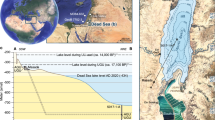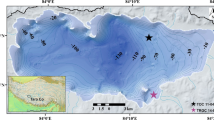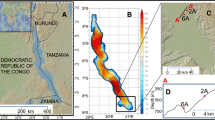Abstract
The sedimentology of an 8.22-m long core of late-Holocene deposits in the submerged Crescent Island Crater basin of Lake Naivasha, Kenya, is used to reconstruct decade-scale fluctuations in lake-surface elevation during the past 1800 yrs. Lake-depth inference for the past 1000 yrs is semi-quantitative, based on (1) relationships between lake level and bottom dynamics predicted by wave theory, and (2) historical validation of the effects of lake-level fluctuation and hydrologic closure on sediment composition in Crescent Island Crater and nearby Lake Oloidien. In these shallow fluctuating lakes, organic-carbon variation in a lithological sequence from clayey mud to algal gyttja is positively correlated with lake depth at the time of deposition, because the focusing of oxidized littoral sediments which dilute autochthonous organic matter before burial is reduced during highstands. The lake-level reconstruction for Lake Naivasha agrees with other adequately dated lake-level records from equatorial East Africa in its implication of dry climatic conditions during the Mediaeval Warm Period and generally wet conditions during the Little Ice Age. Crescent Island Crater survived widespread aridity in the early-19th century as a fresh weedy pond, while the main basin of Lake Naivasha and many other shallow East African lakes fell dry and truncated their sediment archive of Little Ice Age climatic variability.
Similar content being viewed by others
References
Appleby, P. G. & F. Oldfield, 1978. The calculation of lead-210 dates assuming a constant rate of supply of unsupported 210Pb to the sediment. Catena 5: 1–8.
Åse, L.-E., K. Sernbo & P. Syrén, 1986. Studies of Lake Naivasha, Kenya, and its drainage area. Forskningsrapp. Naturgeogr. Inst. Stockholms Univ. 63: 1–75.
Barton, C. E., D. K. Solomon, J. R. Bowman, T. E. Cerling & M. D. Sayer, 1987. Chloride budgets in transient lakes: lakes Baringo, Naivasha, and Turkana. Limnol. Oceanogr. 32: 745–751.
Beadle, L. C., 1932. Scientific results of the Cambridge expedition to the east African lakes, 1930–1931. 4. The waters of some East African lakes in relation to their fauna and flora. J. Linn. Soc. (Zool.) 38: 157–211.
Bonnefille, R. & U. Mohammed, 1994. Pollen-inferred climatic fluctuations in Ethiopia during the last 3000 yrs. Palaeogeogr. Palaeoclimatol. Palaeoecol. 109: 331–343.
Bradley, R. S. & P. Jones, 1993. 'Little Ice Age' summer temperature variations: their nature and relevance to recent global warming trends. Holocene 3: 367–376.
Cohen, A. S., M. R. Talbot, S. M. Awramik, D. L. Dettman & P. Abell, 1997. Lake level and paleoenvironmental history of Lake Tanganyika, Africa, as inferred from late Holocene and modern stromatolites. Geol. Soc. Am. Bull. 109: 444–460.
Crossley, R., S. Davison-Hirschmann, R. B. Owen & P. Shaw, 1984. Lake-level fluctuations during the last 2,000 yrs in Malawi. In J. C. Vogel (ed.), Late Cenozoic Palaeoclimates of the Southern Hemisphere, Balkema, Rotterdam, 305–316.
Darling, W. G., D. J. Allen & H. Armannsson, 1990. Indirect detection of subsurface outflow from a rift valley lake. J. Hydrol. 113: 297–305.
Dean, W. E., 1974. Determination of carbonate and organic matter in calcareous sediments and sedimentary rocks by loss on ignition: comparison with other methods. J. Sed. Petrol. 44: 242–248.
Dean, W. E. & E. Gorham, 1976. Major chemical and mineral components of profundal surface sediments in Minnesota lakes. Limnol. Oceanogr. 21: 259–284.
Dearing, J. A., 1997. Sedimentary indicators of lake-level changes in the humid temperate zone: a critical review. J. Palaeolim. 18: 1–14.
DeMaster, D. J., 1981. The supply and accumulation of silica in the marine environment. Geochim. Cosmochim. Acta 45: 1715–1732.
Digerfeldt, G., 1986. Studies on past lake-level fluctuations. In B. E. Berglund (ed.), Handbook of Holocene Palaeoecology and Palaeohydrology. Wiley, New York, 127–143.
Fontes, J.-Ch., 1992. Chemical and isotopic constraints on 14C dating of groundwater. In R. E. Taylor, A. Long & R. S. Kra (eds), Radiocarbon After 4 Decades: An Interdisciplinary Perspective. Springer, New York, 242–261.
Gaudet, J. J. & J. M. Melack, 1981. Major ion chemistry in a tropical African lake basin, Freshwat. Biol. 11: 309–333.
Håkanson, L., 1977. The influence of wind, fetch, and water depth on the distribution of sediments in Lake Vänern, Sweden. Can. J. Earth Sci. 14: 397–412.
Håkanson, L., 1982. Lake bottom dynamics and morphometry-the dynamic ratio. Wat. Resources Res. 18: 1444–1450.
Halfman, J. D., T. C. Johnson & B. P. Finney, 1994. New AMS dates, stratigraphic correlations and decadal climatic cycles for the past 4 ka at Lake Turkana, Kenya. Palaeogeogr. Palaeoclimatol. Palaeoecol. 111: 83–98.
Harper, D. M., K. M. Mavuti & S. M. Muchiri, 1990. Ecology and management of Lake Naivasha, Kenya, in relation to climatic change, alien species' introductions, and agricultural development. Envir. Conserv. 17: 328–336.
Harper, D. M., G. Phillips, A. Chilvers, N. Kitaka & K. Mavuti, 1993. Eutrophication prognosis for Lake Naivasha, Kenya, Verh. Internat. Verein. Limnol. 25: 861–865.
Hilton, J., 1985. A conceptual framework for predicting the occurrence of sediment focusing and sediment redistribution in small lakes. Limnol. Oceanogr. 30: 1131–1143.
Kemp, A. E. S. & J. G. Baldauf, 1993. Vast Neogene laminated diatom mat deposits from the eastern equatorial Pacific Ocean. Nature 362: 141–144.
Leonard, E. M., 1986. Use of lacustrine sedimentary sequences as indicators of Holocene glacial activity, Banff National Park, Alberta, Canada. Quat. Res. 26: 218–231.
MacIntyre, S. & J. M. Melack, 1982. Meromixis in an equatorial African soda lake. Limnol. Oceanogr. 27: 595–609.
Maley, J., 1976. Les variations du lac Tchad depuis un millenaire: conséquences paleoclimatiques. Palaeoecol. Afr. 9: 44–47.
Nicholson, S. E., 1995. Environmental change within the historical period. In A. S. Goudie, W. M. Adams & A. Orme (eds), The Physical Geography of Africa. Oxford University Press, Oxford, 60–75.
Ojiambo, B. S. & W. B. Lyons, 1996. Residence times of major ions in Lake Naivasha, Kenya, and their relationship to lake hydrology. In T. C. Johnson & E. Odada (eds), The Limnology, Climatology and Paleoclimatology of the East African Lakes. Gordon & Breach, Newark, 267–278.
Owen, R. B. & R. Crossley, 1989. Recent sedimentation in lakes Chilwa and Chiuta, Malawi. Palaeoecol. Afr. 20: 109–117.
Owen, R. B., R. Crossley, T. C. Johnson, D. Tweddle, I. Kornfield, S. Davison, D. Eccles & D. R. Engstrom, 1990. Major low levels of Lake Malawi and their implications for speciation rates in cichlid fish. Proc. Roy. Soc. Lond. B240: 519–553.
Richardson, J. L. & R. A. Dussinger, 1986. Paleolimnology of midelevation lakes in the Kenya Rift Valley. Hydrobiologia 143: 167–174.
Richardson, J. L. & A. E. Richardson, 1972. History of an African Rift lake and its climatic implications. Ecol. Monogr. 42: 499–534.
Round, F. E., 1981. The ecology of algae. Cambridge University Press, Cambridge.
Rowan, D. J., J. Kalff & J. B. Rasmussen, 1992. Estimating the mud deposition boundary depth in lakes from wave theory. Can. J. Fish. Aquat. Sci. 49: 2490–2497.
Smetacek, V. S., 1985. Role of sinking in diatom life-history cycles: ecological, evolutionary and geological significance. Mar. Biol. 84: 239–251.
Souch, C., 1994. A methodology to interpret downvalley lake sediments as records of neoglacial activity: Coast Mountains, British Columbia, Canada. Geogr. Ann. 76A: 169–185.
Stager, J. C., B. Cumming & L. Meeker, 1997. A high-resolution 11,400-yr diatom record from Lake Victoria, east Africa. Quat. Res. 47: 81–89.
Stuiver, M. & P. J. Reimer, 1993. Extended 14C data base and revised CALIB 3.0 14C age calibration program. Radiocarbon 35: 215–230.
Talbot, M. R. & P. A. Allen, 1996. Lakes. In H. G. Reading (ed.), Sedimentary Environments: Processes, Facies, and Stratigraphy. Blackwell, Oxford, 83–124.
Tiercelin, J. J. et al., 1987. Le demi-graben de Baringo-Bogoria, Rift Gregory, Kenya: 30.000 ans d'histoire hydrologique et sédimentaire. Bull. Centr. Rech. Expl.-Prod. Elf-Aquitaine 11: 249–540.
Tyson, P. D. & J. A. Lindesay, 1992. The climate of the last 2000 yrs in southern Africa. Holocene 2: 271–278.
Verschuren, D., 1993. A lightweight extruder for accurate sectioning of soft-bottom lake sediment cores in the field. Limnol. Oceanogr. 38: 1796–1802.
Verschuren, D., 1996. Comparative paleolimnology in a system of four shallow, climate-sensitive tropical lake basins. In T. C. Johnson and E. Odada (eds), The Limnology, Climatology and Paleoclimatology of the East African Lakes. Gordon & Breach, Newark, 559–572.
Verschuren, D., 1999a. Sedimentation controls on the preservation and time resolution of climate-proxy records from shallow fluctuating lakes. Quat. Sci. Rev. 18: 821–837.
Verschuren, D., 1999b. Influence of lake depth and mixing regime on sedimentation in a small, fluctuating tropical soda lake. Limnol. Oceanogr. 44: 1103–1113.
Verschuren, D., J. Tibby, P. R. Leavitt & C. N. Roberts, 1999. The environmental history of a climate-sensitive lake in the former 'White Highlands' of central Kenya. Ambio 28: 494–501.
Verschuren, D., J. Tibby, K. Sabbe & C. N. Roberts, 2000. Effects of lake level, salinity and substrate on the invertebrate community of a fluctuating tropical lake. Ecology, 81: 164–182.
Whitmore, T. J., M. Brenner & C. L. Schelske, 1996. Highly variable sediment distribution in shallow, wind-stressed lakes: a case for sediment-mapping surveys in paleolimnological studies. J. Paleolim. 15: 207–221.
Wright, H. E. Jr., 1967. A square-rod piston sampler for lake sediments. J. Sed. Petrol. 37: 975–976.
Wright, H. E. Jr., 1980. Coring of soft lake sediments. Boreas 9: 107–114.
Author information
Authors and Affiliations
Rights and permissions
About this article
Cite this article
Verschuren, D. Reconstructing fluctuations of a shallow East African lake during the past 1800 yrs from sediment stratigraphy in a submerged crater basin. Journal of Paleolimnology 25, 297–311 (2001). https://doi.org/10.1023/A:1011150300252
Issue Date:
DOI: https://doi.org/10.1023/A:1011150300252




